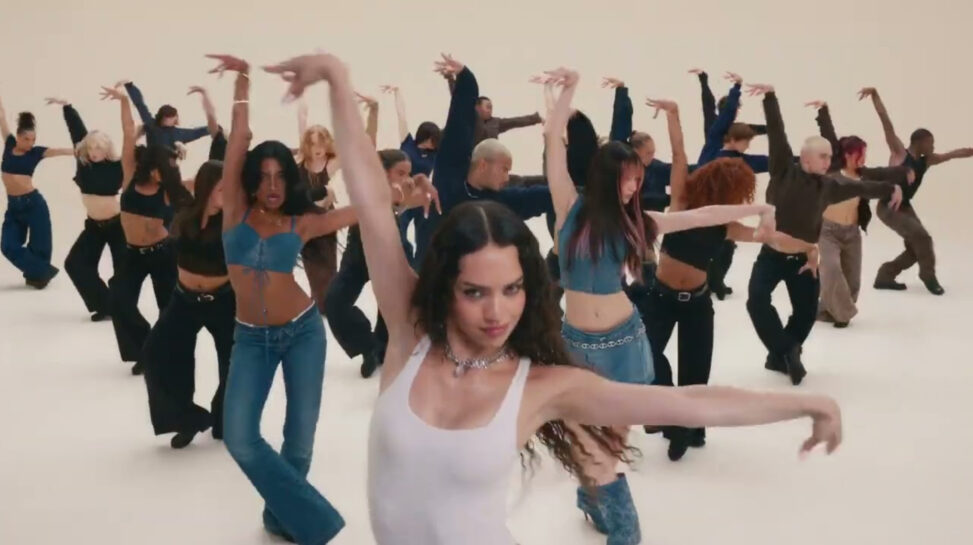“Better in Denim”
Sae Hara
T00783114
September 29, 2025
Introduction
The First time I saw the Gap “Better in Denim” advertisement was while I was watching one of my favorite Korean channels on YouTube. I do not remember exactly which video it was, but the advertisement appeared suddenly before the video started. The commercial immediately caught my attention because of its strong music beats and energetic dance performance. The song was very catchy and easy to remember. The dance moves were also lively and made me want to watch it again. Even though I usually watch short videos from the Xiao Hong Shu app, I have seen many times while using it. The KATSEYE campaign by Gap highlights diversity and self-expression. By showing models and dancers of diverse races, genders, and styles, the company promotes an image of social responsibility. In this essay, I will analyze this advertisement, focusing on the messages it conveys regarding diversity and social responsibility.
Messages and represents
The “Better in Denim” advertisement promotes Gap as a socially responsible company that supports diversity and self-expression. KATSEYE is a global pop group with members from different cultural backgrounds. From the video, each members wear colorful denim outfits that highlight their own personal style, which matches the campaign’s message of individuality and diversity. They perform, which makes the commercial even more catchy and memorable with the song. The dancers move in layers, with more performers joining at the beginning. At the end, the performers walk together, and they make a circle shape to symbolize togetherness and community. By showing performers looking and moving differently, the advertisement implies that Gap is not just about fashion but also cares about supporting social issues and all kinds of people.
Target and Goal
In the past, Gap has targeted younger consumers, especially in the 17-25 age segment. However, the company did not do well, because it was less connected to social media. To solve this, the company is targeting Gen Z to sell denim clothing rather than mom jeans. The campaign uses music, dance, and KATSEYE‘s colorful, diverse style to appeal to their brand on social media. Gap successfully connects with Gen Z and is getting more diverse. Especially this time, the “Better in Denim” advertisement reached over 400 million organic views online and inspired numerous viral user-generated content. It also increased foot traffic by more than 8.5%, showing that young people were not just watching the video but also visiting Gap stores. The song “Milkshake” was a hit for Millennials in the 2000s, and Gen Z audiences who encounter it again through TikTok also feel nostalgic for Millennials. This strategy has been highly effective, increasing brand awareness and fostering strong engagement. As a member of the active social media, music, and trends, I feel included in Gap’s target audience. The advertisement makes me think of the Gap brand, encouraging me to express myself and share my values.
Analysis of advertising
In advertising, semiotics helps us understand how viewers are guided to read from images, music, and movement. From a visual perspective, models of different genders, races, and body shapes can show ideas of freedom, equality, and diversity. Dance can represent energy and self-expression, which allows viewers to feel it while watching the video. Besides these visual signs, music plays a significant role in advertising. Research shows that it can influence how people think and affect their shopping behavior. Gatewood (Matsa and Priyanka 2024, p. 5) found that different types of music evoke distinct emotions, such as happiness, excitement, or sadness. For example, quick and rhythmic tunes were linked with joy and movement, while hymns were considered serious, and funeral marches were viewed as sad. This demonstrates how strongly music can shape perception. In marketing, music has been shown to influence attitudes and encourage people to purchase the products (Matsa and Priyanka 2024, p. 7). These findings help explain why the catchy song and energetic dance in the Gap advertisement make viewers feel more excited and connected to the brand.
The Gap advertisement is also designed to be shared on social media platforms like TikTok and Instagram. Today’s young generation, music and dance not just as entertainment, but as ways of communicating and expressing themselves. Especially on social media, short videos with catchy sounds and creative moves can spread very quickly. According to the research, “Gen Z favors short, engaging content that gets to the point quickly. They enjoy memes, trends, and user-generated content, and they often participate in viral challenges themselves” (Wagner, 2008, p. 8). By combining dance, music, and diverse models, the Gap advertisement becomes more effective and memorable. The combination of visual signs and social sharing enables Gap to create a strong emotional and cultural connection with the audience.
Conclusion
In conclusion, the Gap “Better in Denim” advertisement successfully combines social media to connect with Generation Z. The diverse models, energetic dance, and catchy song convey signs of freedom, individuality, and identity. Moreover, the advertisement target and style have changed from traditional commercials. They use social media, allowing young audiences to participate and become co-creators. By doing this, Gap builds emotional and cultural connections with its audience. Overall, the campaign shows that a brand can use creativity and social media to engage consumers and build relationships, rather than just selling products.
Reference
Contact Pigeon. “Gap Marketing Strategy: How the American Clothing Retailer Scaled to Over 3000 Stores,” May 26, 2023. Accessed September 26, 2025. https://blog.contactpigeon.com/gap-marketing-strategy/
Gap. “Gap Unveils Fall Denim Campaign Starring global Girl Group KATSEYE.” GAP INC., August 19, 2025. Accessed September 26, 2025. https://www.gapinc.com/en-us/articles/2025/08/gap-unveils-fall-denim-campaign-starring-global-gi
Matsa Prasanna, A. Lakeshmi Priyanka. “Marketing to Gen Z: Understanding the Preferences and Behaviors of Next Generation.” Vol. 6, No. 4, (July-August 2024): 5,7-8. Accessed September 29, 2025. https://www.researchgate.net/profile/Asi-Priyanka/publication/383434299_Marketing_to_Gen_Z_Understanding_the_Preferences_and_Behaviors_of_Next_Generation/links/66cdc56cb870b50dab84b5ce/Marketing-to-Gen-Z-Understanding-the-Preferences-and-Behaviors-of-Next-Generation.pdf
Varga, Anna. “Gap’s Marketing Strategy in 2025: Reinventing Heritage for the TikTok Era.” OptiMonk, September 19, 2025. Accessed September 26, 2025. https://www.optimonk.com/gap-marketing-strategy/
Winsome Marketing. “Semiotics in marketing: Symbols and Signs.” May 8, 2025. Accessed September 29, 2025. https://winsomemarketing.com/winsome-marketing/semiotics-in-marketing-symbols-and-signs
Wagner, Mary S. “The Effect of Music/Brand Congruity on Advertising and Brand Evaluations.” 2008. 8-124. Accessed September 29, 2025. https://deepblue.lib.umich.edu/bitstream/handle/2027.42/61671/rumpus_1.pdf?sequence=1


Ila Watson
I chose this submission because I was familiar with the GAP advertisement and was curious about the claims that the company was allegedly greenwashing. This student did an excellent job analyzing this advertisement, she explained both the visual elements as well as the psychological message the advertisement was intending to communicate. She highlights how GAP is a well-known company that supports self-expression and diversity, this is reflected in the advertisement through the partnership with the pop group KATSEYE, whose members come from different cultures. This advertisement was extremely successful, gaining over 400 million views, targeting Gen Z and Millennials through social media platforms. She explains how the upbeat music and memorable dance used in the advertisement create positive emotions that connect viewers to the brand. This student used 2 scholarly sources, Understanding the Preferences and Behaviors of Next Generation (Matsa Prasanna & A. Lakshmi Priyanka 2024) and The Effect of Music/Brand Congruity on Advertising and Brand Evaluations (Mary S. Wagner 2008), she also used 3 additional sources that related to the article, however they are not scholarly. I think that this student failed to expand on how this advertisement was engaging with greenwashing, she did not mention how this advertisement or the company was claiming to be ecologically friendly/responsible. Overall, I think she did an exceptional job explaining the design and emotional appeal of this advertisement as well as how viewers are influenced to shop at GAP.